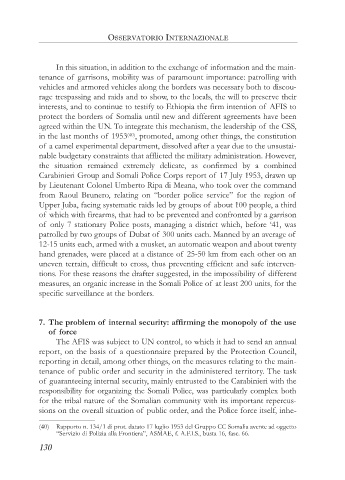Page 132 - Rassegna 2021-4
P. 132
OSSERVATORIO INTERNAZIONALE
In this situation, in addition to the exchange of information and the main-
tenance of garrisons, mobility was of paramount importance: patrolling with
vehicles and armored vehicles along the borders was necessary both to discou-
rage trespassing and raids and to show, to the locals, the will to preserve their
interests, and to continue to testify to Ethiopia the firm intention of AFIS to
protect the borders of Somalia until new and different agreements have been
agreed within the UN. To integrate this mechanism, the leadership of the CSS,
(40)
in the last months of 1953 , promoted, among other things, the constitution
of a camel experimental department, dissolved after a year due to the unsustai-
nable budgetary constraints that afflicted the military administration. However,
the situation remained extremely delicate, as confirmed by a combined
Carabinieri Group and Somali Police Corps report of 17 July 1953, drawn up
by Lieutenant Colonel Umberto Ripa di Meana, who took over the command
from Raoul Brunero, relating on “border police service” for the region of
Upper Juba, facing systematic raids led by groups of about 100 people, a third
of which with firearms, that had to be prevented and confronted by a garrison
of only 7 stationary Police posts, managing a district which, before ‘41, was
patrolled by two groups of Dubat of 300 units each. Manned by an average of
12-15 units each, armed with a musket, an automatic weapon and about twenty
hand grenades, were placed at a distance of 25-50 km from each other on an
uneven terrain, difficult to cross, thus preventing efficient and safe interven-
tions. For these reasons the drafter suggested, in the impossibility of different
measures, an organic increase in the Somali Police of at least 200 units, for the
specific surveillance at the borders.
7. The problem of internal security: affirming the monopoly of the use
of force
The AFIS was subject to UN control, to which it had to send an annual
report, on the basis of a questionnaire prepared by the Protection Council,
reporting in detail, among other things, on the measures relating to the main-
tenance of public order and security in the administered territory. The task
of guaranteeing internal security, mainly entrusted to the Carabinieri with the
responsibility for organizing the Somali Police, was particularly complex both
for the tribal nature of the Somalian community with its important repercus-
sions on the overall situation of public order, and the Police force itself, inhe-
(40) Rapporto n. 134/1 di prot. datato 17 luglio 1953 del Gruppo CC Somalia avente ad oggetto
“Servizio di Polizia alla Frontiera”, ASMAE, f. A.F.I.S., busta 16, fasc. 66.
130

